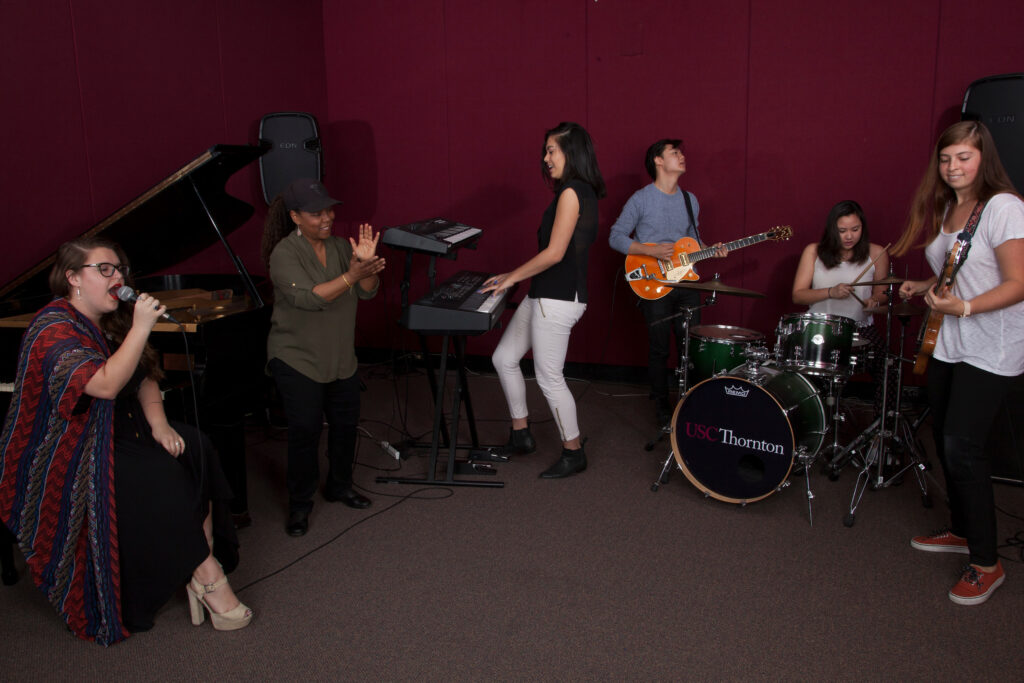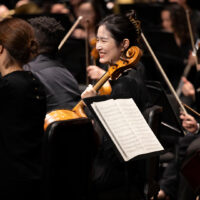
Trending Everywhere
By Julie Riggott

USC Thornton Popular Music Program Chair Patrice Rushen is a model for what’s possible in a music career.
Patrice Rushen was definitely not the first to know when her 1982 hit song “Forget Me Nots” launched a dance challenge on TikTok.
“My cell phone started blowing up with messages from my students: ‘You’re trending on TikTok! You’re trending on TikTok!’” said the chair of the USC Thornton Popular Music program.
Rushen earned her first GRAMMY Award nomination for that dance-funk single and has seen it remain a part of popular culture over the past four decades. It was featured in the 1988 Tom Hanks movie Big and sampled by Will Smith for the 1997 Men in Black movie theme song. In 2000, it was ranked 34 on VH1’s 100 Greatest Dance Songs, and Rushen still gets a regular stream of requests from artists who want to sample it in their work. It was a phenomenon before it ever hit TikTok. So, when Rushen heard it was trending on the video sharing app, she probably shrugged as she said, “OK, that’s nice.”
Then, her daughter said, “Mom, are you watching TikTok?” Her website developer in the Netherlands asked, “Are you seeing what’s going on worldwide?” And Rushen learned the dance challenge had gone viral — with tens of millions of views.
“It’s crazy when I think back to what we had to do to just give the song a chance to get out there,” said Rushen, who co-wrote the song with bassist Freddie Washington and songwriter Terri McFaddin. “The record company, those many years ago, didn’t hear it. They didn’t like it. We put our pennies together and paid for three weeks of independent promotion just to get it to the radio stations. And it took off.”
“Forget Me Nots” peaked on the Billboard Top 40 pop chart at No. 23, the R&B chart at No. 4 and the dance chart at No. 2.
“It just kept going, going, going, worldwide,” Rushen said. “And it just keeps going on. So here we come back around, and it’s on TikTok. But this time, what’s so cool about it for me is that I’m the one being the hashtag now. I’m getting the credit, whereas before people used to associate it with something else.”
Rushen can’t help but be amazed.
“This has been really cool to see the dances worldwide,” she said. “I’m saying, wow, this is like I’m living the dream, because the kind of musician that I always wanted to be was one able to share in these various worlds and dialects of music, to participate in the classical stage, jazz, dance music, R&B and pop — to just go across genres — because of the joy that all of those musics bring me. And now, that’s what I’m seeing.”
Trending in Classical and Jazz

Rushen is referring to the fact that she’s “trending” in the classical and jazz worlds right now, too. One of her symphonic pieces, “Sinfonia,” was part of Symphony Tacoma’s Oct. 23 season-opening program (and first post-pandemic concert), along with Shostakovich and Tchaikovsky. She is also working on three commissions: a piece for jazz nonet for the Detroit Chamber Wind and Strings as part of the Resonate project with the Carr Center in which seven American composers explore the African diaspora, scheduled to premiere next May; and two pieces for Key to Change’s young persons’ violin ensemble, set to debut in January 2022.
“From one side of the musical spectrum to the other,” Rushen said, “I’m enjoying the beautiful feeling of having my music in so many places, for so many people, all discovering what fun I’m having and defining some joy for themselves in it, too.”
Quinton Morris started the Key to Change studio to provide music instruction to underserved youth in Washington. Outreach has always been a priority for Rushen, who shares her time and talents with the Los Angeles Cultural Affairs Department, The National Academy of Recording Arts and Sciences’ GRAMMY in the Schools program and other organizations dedicated to music education and mentorship for inner-city youth.
A classically trained pianist who earned her degree at USC and later studied orchestration and conducting, Rushen wrote her first symphony, “Sinfonia,” in 1999 after decades of working with smaller ensembles.
“The piece was really a reaction to not having the full palette of orchestral instruments,” Rushen said. “I wanted to use every color.”
After she wrote the first movement to “Sinfonia,” she was literally boxing it up — “I had my cathartic moment and said, ‘OK, cool. It’s out of my system now.’” — when composer William Banfield called to chat and discovered what she’d written. He encouraged her to enter a reading competition with an orchestra, hosted by the American Composer’s Forum with members of St. Paul Chamber Orchestra. St. Paul and the Detroit Symphony chose her work to perform.
A Model for What’s Possible
Patrice Rushen has seemingly done it all. She signed with the Prestige record label at 17, Elektra at 23 and has recorded 13 solo albums. A three-time GRAMMY Award nominee in R&B and jazz, she has also enjoyed a long career as a film and television composer and as a record producer for the likes of Sheena Easton. She became the first woman to serve as head composer and musical director for the Emmy Awards, the NAACP Image Awards, the People’s Choice Awards and Comic Relief V. She later added the GRAMMYs to her musical direction resume. Indeed, there are far too many career accomplishments to list.
Given the depth and breadth of her work across genres and generations, Rushen is a model for the kind of multifaceted career USC Thornton students are encouraged to build.
“If I’m a model,” she said, “it’s a model for what’s possible.”

As a professor and mentor, Rushen educates and inspires her students to find their passion and purpose, to understand the “sometimes painfully slow and gradual” process (even for GRAMMY nominees) of building a career step by step and to embrace Thornton’s spirit of community.
“In the popular music program, we need to take care of each other, lift each other up and inspire one another,” Rushen said.
She believes Thornton and the popular music program have been able to encourage all of those things, while giving students opportunities and exposure to different techniques, ideas and musical styles. The school is unique in that every genre is represented and students can collaborate and build diverse networks.
“Having the kind of diverse interests and expertise within the faculty ranks at Thornton has allowed for a rare kind of communication,” said Rushen who, for example, has brought her symphonic work into composition classes for professors and students to analyze the orchestration techniques.
“That communication has brought a modern awareness to the table to enhance the music education of the 21st century,” Rushen said. “Music education requires a certain interdisciplinary consciousness and awareness of the intersection of all of the different kinds of music. And we’re doing it.”

